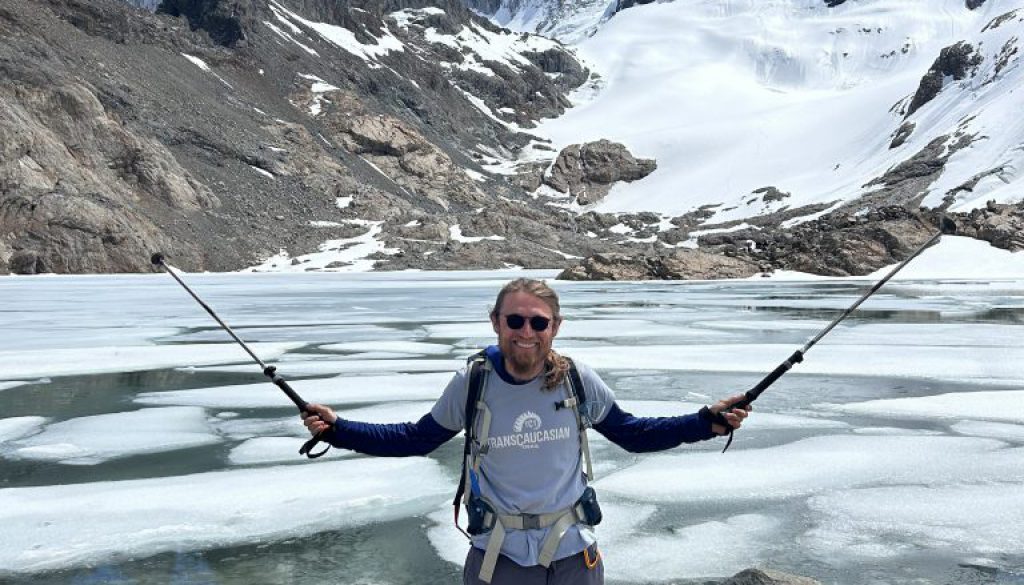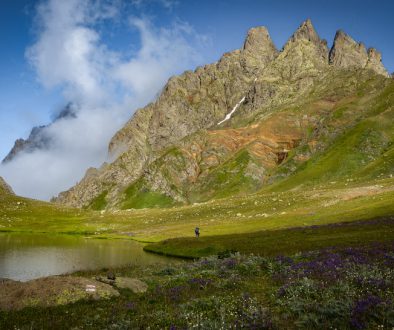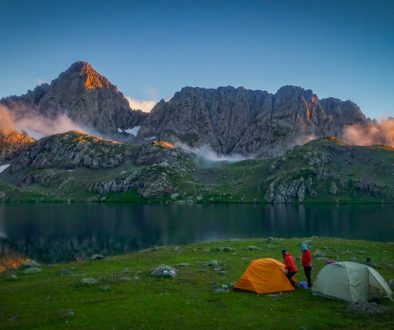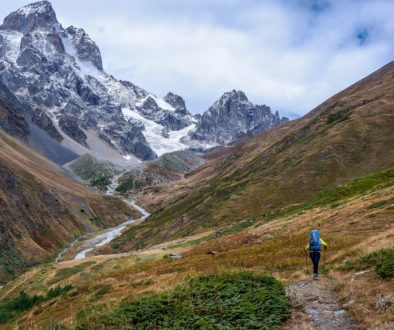TCT Builds a Trail in Patagonia
Giorgi (Gio) Jmukhadze, TCT Georgia’s technical manager, recently returned from Patagonia, where he spent 6 weeks as a volunteer trail builder with the Freyja Foundation. He learned different methods of trail building and design, and spent a couple weeks traveling around the region at the end of his program. Gio was excited to share his experience with us!

Can you tell us about this project? What did you do when you were there?
I went through the Freyja Foundation, a nonprofit foundation based in the US. The original idea for the foundation was to be for medical care, but they do environmental education projects now. I volunteered with their project in Parque Patagonia National Park in Argentina. This specific project was focused near Cueva de los Manos, a UNESCO site in Santa Cruz province.
This year’s goal is to build a 5-kilometer trail to a canyon in that area. The foundation had already built some trails over the past two or three years, and this is the last year they will build trails there.
We were this year’s first group of volunteers, and our goal was to do as much as we could during our volunteer period.


You were building a brand new trail?
Yeah, it was brand new. We weren’t doing maintenance or anything, just building from scratch.
Can you tell us about the terrain? What environmental factors did you encounter when you were in the field?
There was wind all the time, and it was in the desert. There were some small bushes and grass, but no green forest. The soil was really dry, not like we have in Mestia or Zeskho, and really compact. Some areas were sandy.
Did you use different techniques there than you’ve used in Georgia because the terrain was so different?
Yeah, slightly different techniques. When we start building a trail here, for example, we have to brush the trees and branches and clear the path from trees and vegetation. But in Patagonia, we started with cutting the tread
[the surface of a trail]. We might have had to cut one or two small branches or bushes or a little bit of grass, but it didn’t take long. Sometimes we started cutting the backslope, and then we benched and cut the outslope. Some people liked to bench first and then do the backslope. It depended on how steep the terrain was. If the terrain wasn’t steep, it was better to start with benching and then cut the backslope. The techniques weren’t too different from how we bench in Georgia. But it was different in the beginning because we didn’t have to cut any trees. If we had to dig anything, it was impossible to pack the earth because everything was so dry.

So was it easier to build the trail in Patagonia because you didn’t have to brush as much?
If we define “ease” by the length of trail we were able to build in a specific time period, it was easier because we didn’t have to spend time clearing vegetation. In Georgia, we have to clear the path the trail will take and remove ground soil that often contains heavy root systems. That takes a lot of time. In Patagonia, the terrain was so different that we didn’t have to do that, and we could just start benching.
Otherwise, the cutting was the same or maybe even more difficult because the soil was harder than it is in Georgia. The wind dried it out, and it became hard and compact.
Why did you want to get involved in this project?
First of all, I wanted to see a new country and Patagonia. I didn’t know so much about Patagonia, but I knew that I had to apply. The drive was to be in a new area and learn a new style of trail building.
I also liked being able to just volunteer and not have to organize anything. I wanted to enjoy trail building, which I had been missing for a long time. I also wanted to meet new people, experience a new culture, and see how people live there.

What was your daily schedule like?
On work days, we left the ranger station where we were staying by 8:00am, and we worked until 4:30pm. It took about ten minutes to drive to the site from where we were staying, and then we hiked to the specific spot where we were working that day. We had a lunch break and 10- or 15-minute breaks during the day.
After work, we came back and cooked group dinners. Two of us were usually in charge of dinner each night. Sometimes we had showers, but not every day because sometimes we didn’t have water or heat. Since we were at the ranger station, not in town, everything was kind of limited. And of course we played games and relaxed, too.
How many other volunteers were with you? Was it a big group?
There were five of us—one crew leader and four volunteers in my crew. We were all experienced trail builders, and everyone was American except for me. Two Argentinian rangers lived with us, too. The communication was good, and we helped each other if we needed anything. One of the rangers didn’t know English very well, but some of our crew members knew Spanish and enjoyed practicing. It was really nice having that group there.

What did you learn about American and Argentinian cultures while you were there?
I spent seven months living in the US in 2018, so I already knew a lot about American culture. But I learned new things about trail work, trail design, and rock work. I enjoyed getting to know the Argentinians.
On weekends, we went to the other side of the canyon where the Argentinian crew was based. We had Argentinian barbecue and played an Argentinian card game called truco. We also had a stylish Argentinian drink called fernet. You mix it with Coca Cola and big ice cubes. The barbecue style was interesting. It was really slow, which is different from how we barbecue in Georgia.
You did some sightseeing and hiking afterwards, right?
Yeah, I stayed almost two weeks after the project finished. I went to a small town called El Chaltén, which is near Mt. Fitzroy. Mt. Fitzroy is pretty popular and is the mountain on the logo of the Patagonia brand. I stayed there a few days and saw Mount Fitzroy and some lakes and glaciers. The lake was still frozen because summer was just starting. It was the opposite season from Georgia—winter was coming here, but spring was coming there.
Then I went to El Calafate, a bigger town than El Chaltén. I saw the Perito Moreno glacier, which flows down to a lake. This glacier is about 70 meters (230 feet) tall—pictures cannot explain how big it is! I saw some big pieces from the glacier fall into the lake. I managed to get some of it on video, which is incredible.
It was my first time in Patagonia, so there are still a lot of hikes that I didn’t get to do. There’s a big ice field that you can see from the hike I did. Even bigger than the one I saw in El Calafate. Hopefully one day I can do that.


What was your favorite part of your volunteer experience?
I had experience in trail building and design, so I wasn’t learning everything from scratch. I liked talking with experienced trail designers and learning from them. Sometimes I’d ask them questions that I already knew the answers to, and they gave me more detailed explanations and tips that helped me understand things more deeply. They also confirmed a lot of what I already knew, and it was nice to know that I knew how to do things correctly.
They use the landscape and take time to consider the environment when they plan and design the trail. When you build a trail, you change that area forever, so you have to think carefully about its placement. It was nice to see how deeply they think about this.
What are you bringing back to Georgia from this experience? Are you going to do anything differently in the way that you work?
I want to spend more time scouting so we know the small details of where the trail can go and which way will be better. When people think of trail building, they don’t really think about the scouting part, but that part is really important.

Thanks to Gio for sharing your experience and big thanks to the Freyja Foundation and Parque Patagonia for this opportunity!






